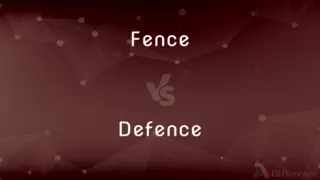Stockade vs. Palisade — What's the Difference?
Edited by Tayyaba Rehman — By Fiza Rafique — Updated on April 29, 2024
A stockade is a barrier formed from upright wooden stakes used for defense, whereas a palisade, also made of wooden stakes, is typically taller and used for fortification in more permanent structures.

Difference Between Stockade and Palisade
Table of Contents
ADVERTISEMENT
Key Differences
A stockade is primarily a defensive barrier, often hastily constructed with available timber and used temporarily in military or colonial settings. On the other hand, a palisade is designed as a more permanent structure, commonly seen in the fortifications of settlements or forts, indicating a planned defense strategy.
Stockades are generally shorter and more rudimentary in construction, suitable for quick assembly in emergency situations. Whereas palisades are taller and more robust, forming formidable barriers that are often part of a larger defensive architecture.
The construction of a stockade typically involves less preparation of the timber, with the wood often being roughly hewn and not necessarily shaped to interlock. In contrast, palisades may involve more processed wood, sometimes sharpened to points at the top to deter climbers.
Stockades serve well in temporary encampments or as makeshift boundaries to deter small-scale threats. On the other hand, palisades are used in more strategic, long-term defense scenarios where durability and strength are required against more severe assaults.
In historical contexts, stockades were commonly used by smaller, mobile groups such as expeditionary forces or during frontier skirmishes. Palisades, however, were integral to the defense of permanent establishments, such as early colonial towns or ancient fortified settlements.
ADVERTISEMENT
Comparison Chart
Height
Shorter, typically not designed to completely prevent entry
Taller, designed to prevent or significantly deter entry
Construction Speed
Quickly erected, often using readily available materials
Requires more time and preparation, with a focus on durability
Usage Context
Temporary defensive measures or enclosures
Permanent fortifications in settlements or military bases
Wood Preparation
Roughly hewn, minimal processing
More finished, often sharpened or shaped for better defense
Defensive Capability
Provides basic protection, suitable for small threats
Provides substantial protection against larger assaults
Compare with Definitions
Stockade
A historical term used in narratives of early American and colonial settings.
The frontier town was surrounded by a formidable wooden stockade.
Palisade
Symbolically used to represent strong defensive measures or strategies.
The company's legal team was like a palisade, protecting it from lawsuits.
Stockade
Used figuratively to describe a barrier or restriction.
The new regulations acted as a stockade against rapid industrial expansion.
Palisade
A fence of stakes forming a defense barrier or fortification.
The medieval village was surrounded by a strong palisade to protect its inhabitants from raiders.
Stockade
A type of simple fortification used primarily in military contexts.
The soldiers quickly erected a stockade to fend off the approaching enemy.
Palisade
Used in historical or archaeological descriptions of ancient settlements.
Archaeologists uncovered the remains of a palisade that once guarded the ancient city.
Stockade
An enclosure for prisoners or livestock.
Captured cattle were kept in the stockade until claimed by their owners.
Palisade
A long, strong stake pointed at the top and set in the ground in rows to form a barrier.
The palisade at the top of the hill deterred the advancing troops.
Stockade
A stockade is an enclosure of palisades and tall walls, made of logs placed side by side vertically, with the tops sharpened as a defensive wall.
Palisade
A structural element in landscape architecture for aesthetic or protective purposes.
The new park features a decorative palisade along its perimeter.
Stockade
A defensive barrier made of strong posts or timbers driven upright side by side into the ground.
Palisade
A palisade, sometimes called a stakewall or a paling, is typically a fence or defensive wall made from iron or wooden stakes, or tree trunks, and used as a defensive structure or enclosure. Palisades can form a stockade.
Stockade
A fenced or enclosed area, especially one used for protection.
Palisade
A fence of pales forming a defense barrier or fortification.
Stockade
A jail on a military base.
Palisade
One of the pales of such a fence.
Stockade
To fortify, protect, or surround with a stockade.
Palisade
Palisades A line of lofty steep cliffs, usually along a river.
Stockade
(military) an enclosure protected by a wall of wooden posts
Palisade
To equip or fortify with palisades or a palisade.
Stockade
(colloquial) a military prison
Palisade
A long, strong stake, one end of which is set firmly in the ground, and the other sharpened.
Stockade
(transitive) To enclose in a stockade.
Palisade
(military) A wall of wooden stakes, used as a defensive barrier.
Stockade
A line of stout posts or timbers set firmly in the earth in contact with each other (and usually with loopholes) to form a barrier, or defensive fortification.
Palisade
A line of cliffs, especially one showing basaltic columns.
Stockade
An inclosure, or pen, made with posts and stakes.
Palisade
(biology) An even row of cells. e.g.: palisade mesophyll cells.
Stockade
To surround, fortify, or protect with a stockade.
Palisade
To equip with a palisade.
Stockade
Fortification consisting of a fence made of a line of stout posts set firmly for defense
Palisade
A strong, long stake, one end of which is set firmly in the ground, and the other is sharpened; also, a fence formed of such stakes set in the ground as a means of defense.
Stockade
A penal camp where political prisoners or prisoners of war are confined (usually under harsh conditions)
Palisade
Any fence made of pales or sharp stakes.
Stockade
Surround with a stockade in order to fortify
Palisade
A line of bold cliffs, esp. one showing basaltic columns; - usually in pl., and orig. used as the name of the cliffs on the west bank of the lower Hudson.
Palisade
To surround, inclose, or fortify, with palisades.
Palisade
Fortification consisting of a strong fence made of stakes driven into the ground
Palisade
Surround with a wall in order to fortify
Common Curiosities
Do stockades and palisades require maintenance?
Yes, both require maintenance to ensure their durability, especially against weathering and decay; however, palisades, being more permanent, generally require more regular maintenance.
Are there modern equivalents to stockades and palisades?
Modern equivalents include security fencing, barbed wire barriers, and other more technologically advanced perimeter defenses, which serve similar protective functions.
Can stockades and palisades be considered environmentally friendly?
They can be environmentally friendly if sourced from sustainable wood and designed to minimize ecological impact, though their environmental friendliness largely depends on the materials and construction methods used.
How do the costs of constructing a stockade compare to a palisade?
Stockades are typically less expensive to construct due to their simpler design and the use of less processed materials, whereas palisades, requiring more refined materials and labor, are costlier.
What types of environments are stockades and palisades most commonly used in?
Stockades are often used in forested or rural areas where wood is readily available, while palisades are common in both rural and urban environments as part of permanent fortifications.
Are there specific techniques used in the construction of palisades that differ from those used in stockades?
Yes, palisades often employ techniques such as interlocking timbers and pointed tops to enhance defense capabilities, unlike the simpler, stake-driven construction of stockades.
What legal considerations exist for building stockades and palisades?
Legal considerations might include local building codes, historical preservation laws, and zoning regulations, which can affect the construction and placement of such structures.
What are the historical significances of stockades and palisades?
Both have significant historical roles in territorial defense and settlement protection, with palisades often associated with permanent establishment and cultural development.
Can stockades and palisades be used for privacy or noise reduction?
While not their primary function, they can provide privacy and some degree of noise reduction, depending on their construction and height.
How quickly can a stockade be built compared to a palisade?
A stockade can be built relatively quickly, often within a day, due to its simpler and more rudimentary design. A palisade takes longer, requiring more detailed construction and preparation.
How do stockades and palisades impact the visual landscape?
Stockades, being simpler and often temporary, have a minimal impact, while palisades, especially in historical or aesthetic contexts, can significantly alter the visual landscape and character of an area.
What are the common failures of stockades and palisades?
Common failures include rotting wood, termite damage, and structural weakening over time, which can compromise their effectiveness as defensive barriers.
How do different cultures utilize stockades and palisades?
Different cultures have utilized these structures in various ways, reflecting local resources, climatic conditions, and defensive needs, from Native American tribes to European settlers.
Share Your Discovery

Previous Comparison
Fence vs. Defence
Next Comparison
Satellite vs. SpacecraftAuthor Spotlight
Written by
Fiza RafiqueFiza Rafique is a skilled content writer at AskDifference.com, where she meticulously refines and enhances written pieces. Drawing from her vast editorial expertise, Fiza ensures clarity, accuracy, and precision in every article. Passionate about language, she continually seeks to elevate the quality of content for readers worldwide.
Edited by
Tayyaba RehmanTayyaba Rehman is a distinguished writer, currently serving as a primary contributor to askdifference.com. As a researcher in semantics and etymology, Tayyaba's passion for the complexity of languages and their distinctions has found a perfect home on the platform. Tayyaba delves into the intricacies of language, distinguishing between commonly confused words and phrases, thereby providing clarity for readers worldwide.
















































